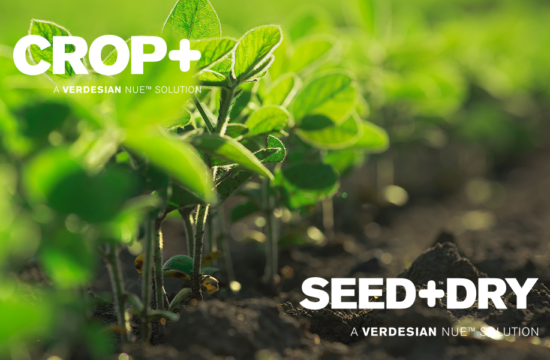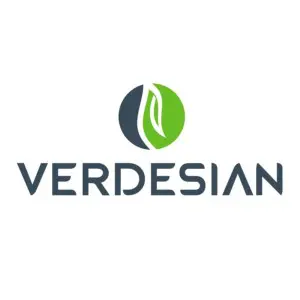Abiotic stress in crop production is a challenge. But growers have stress mitigation solutions.
In this short, seven-minute audio introduction to SEED+DRY and CROP+ technologies, Molly McGrath, Ph.D. and Technical Development Manager at Verdesian Life Sciences, joins Reuel Heyden, Corporate Communications for Verdesian Life Sciences, to provide an introduction to and the fundamentals for these technologies’ chemistries and how they proactively work to protect your crop from abiotic stressors, benefiting plant emergence and growth, nutrient uptake and ultimately increased yield.
Chemistry
Give us a quick introduction to the chemistry behind the technology for SEED+DRY and CROP+.
SEED+DRY and CROP+ are biologically derived nutritional supplements, specifically consisting of fermentation metabolites, naturally chelated micronutrients and plant extracts with CROP+ also containing natural adjuvants.
Both products have multiple modes of action including high antioxidant activity which can reduce the negative impacts of yield-limiting abiotic stress. They also can influence genes in key metabolic pathways. In fact, for example, SEED+ has been shown to influence 1,164 genes involved in various key metabolic processes.
These chemistries influence over a 1,000 genes, tells us how and what specific genes that result in improved crop growth, performance and yield.
The numbers of genes influenced is impressive but, it is what the processes that these genes are associated with that is important. Both SEED+ and CROP+ influence genes involved in key metabolic pathways including photosynthesis, which can result in increased energy and carbohydrate supply, genes involved in lipid metabolic processes which can lead to strengthened cell membranes, and genes involved in carbohydrate metabolic processes which can result in strengthened cell walls and genes related to oxidation-reduction reactions which can protect the plant from reactive oxygen species that are often produced under abiotic stress. In various trials with SEED+ we see better vigor, emergence and root hair development and with both products, the protection from abiotic stress and the influence of genes associated with the key metabolic processes tends to result in increased yields.
There is a way to measure gene expression in plants, share how this is measured and seen.
There are various methods to measure changes in gene expression, microarray technology was used in this case. In the simplest terms, plants or seeds are treated for example with seed+ and other seeds are left untreated. Both are allowed to germinate, live and grow into seedlings under the same conditions, plant material is removed, and genetic material is extracted, tagged with a fluorescent marker and exposed to the microarray chip to hybridize or bind to the microarray that has been tagged known sequences of genetic material that are of interest. The genetic material will only bind to the sequences on the microarray that is a match with. And then you can look hybridization intensity of genes of interest that have been up or down-regulated in comparison to the untreated control. So, the take-away is that the use of Microarray technology is a well understood commonly used tool by scientists to examine changes gene expression and this technology was used to examine the influence SEED+ and CROP+ have on gene expression.
Talk to us about the impact influencing plant photosynthesis genes and what is seen with SEED+DRY and CROP+.
Specifically, an increase in photosynthesis can result in increased energy and carbohydrate supply, so it isn’t a surprise that numerous published scientific studies have shown that an increase in photosynthesis lead to an increase in growth.
It has been shown via microarray that both SEED+ and CROP+ influence genes involved in photosynthesis. With SEED+ they found 53 genes related to photosynthesis were influenced with SEED+ treatment. In a study by Texas A&M on multiple crops treated with CROP+, they found an increase in photosynthesis on average of 16% compared to untreated controls. So we know genes related to photosynthesis are influenced with these products, and we also can measure the increase in photosynthesis.
Help us better understand Reactive Oxygen Species (ROS) and how these technologies Reduce cell damage through antioxidant activity.
Reactive oxygen species are a type of unstable molecule that contains oxygen and that easily reacts with other molecules in a cell. When they react, they can damage essential components of the cell including DNA, cell membranes, endoplasmic reticulum. And abiotic stress has been shown to increase these cells damaging reactive oxygen species. Fortunately, antioxidants can in effect neutralize reactive oxygen species and limit or prevent cell damage. AND SEED+ and CROP+ treatment both result in high antioxidant activity, and as a result, these products can reduce the damaging yield-limiting effects that result when plants are under abiotic stress.
Application and Use
Where would these technologies best fit for a grower?
These products have been tested and demonstrated to increase yields when abiotic stress is present but increases in yield have also been shown when very little abiotic stress is present. It is likely due to the multiple modes-of-action. There is the benefit of the increased antioxidant activity that reduces the damage from reactive oxygen species again often produced due to abiotic stress, but these products also influence genes involved in key metabolic processes like photosynthesis, and these benefits can occur in both the presence and absence of abiotic stress.
Where are obvious case uses for these technologies? What environmental, soil, weather or other growing conditions would these technologies demonstrate their performance best?
In cases where moderate or greater abiotic stress is present, in other words where the antioxidant activity will be most beneficial is where there will likely be the greatest benefit from SEED and CROP+ treatment. For example, drought conditions or planting in cold soils. Those are the conditions where you get the benefits of the antioxidant activity in addition to the benefits from the influence of gene expression of key metabolic pathways.
Where wouldn’t these technologies perform as well?
We anticipate that in cases where there is little abiotic stress and optimal soil types, pH etc. is where we would expect less of an impact because yield potential remains high throughout the growing season. There isn’t much stress to mitigate or growth-limiting conditions to overcome.
What benefits in performance and yield can a grower expect to see using these technologies?
It really depends on environment. We have consistently observed increases in yield in field trials conducted by various research organizations and universities across multiple crops and years.
For example, in various studies by the Irrigation Research foundation, SEED+ increased soybean yields by 12.5%, corn yield by 6.7%, and wheat yields by 7.7% in comparison to controls. 2016 CROP+ trials conducted by Winfield United showed a 5.3% increase in soybean yields and a 4.9% Bu/A increase in corn at stressed locations.
Proof of Performance
Talk to us about the insight we can find from the Winfield Innovation trails done over the past 3 years, between 2016-2018.
With Winfield data with CROP+ we observed a 5.3% increase when CROP+ was applied at V5 and R3 in soybeans and a 4.9% Bu/A increase in corn with the use of CROP+ at stressed locations* which was about a mean 10 Bu/A increase. In Winfield trials with SEED+ Dry applied to corn in 2016, this was with Acceleron and zinc there was a +11 Bu/A mean increase observed in comparison to ACC and zinc alone. We are starting to dive into more of the environmental data and have numerous trials planned for 2019 that will help us look further at the level of yield increase that we can expect under different environmental and field conditions.
To learn more about Seed+Dry or Crop+ technologies, visit Verdesian’s website and search for Seed+Dry or Crop+, contact your local regional Verdesian technical sales representative, contact your local retailer or Winfield United Representative.


